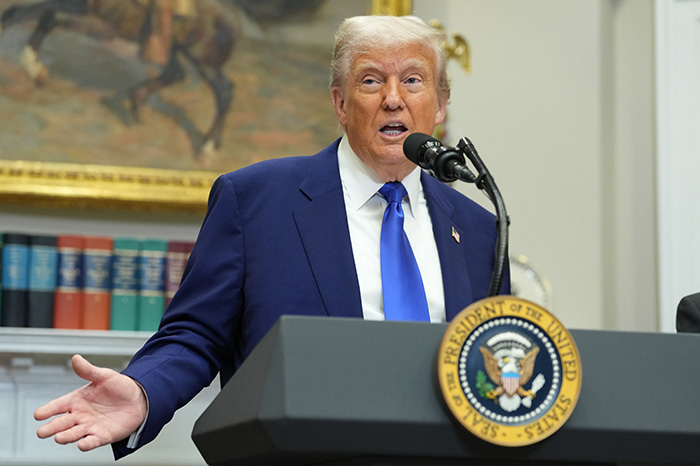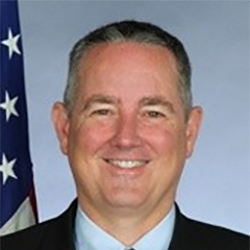Analyses / Political and Geostrategic Observatory of the United States
15 May 2025
Crimes Without a Motive

In just a few months, Donald Trump has transformed his country’s foreign policy — radically, and with surprising effectiveness. But why? To what end? According to what strategy? While it may be possible to understand the changes — the “crimes”, if you like — committed by the American president, it is far more difficult to grasp the motives behind them. In fact, it is genuinely difficult.
It has become something of a cliché to state that Trump is “transactional”, that he sees the world as a zero-sum game in which one can only win or lose. But one would like to believe that the leader of the most powerful country on the planet has some form of global vision, a coherent plan. It would, after all, be reassuring to think that his madness follows a method.
And yet, that is not the case. If anyone ought to know this, it is his former National Security Advisor, John Bolton. In a rather startling opinion piece recently published in Le Monde, Bolton explains that Trump always focuses on tactics, never strategy. For him, “his mental universe consists solely of transactions, with no connection or relationship between them, as though the consequences of one such deal had no bearing on the others.” [1] Bolton concedes that this approach might work in New York real estate, but insists that it is far from appropriate for the leader of a superpower. Trump isn’t playing three-dimensional chess — not even draughts — but tic-tac-toe.
If we accept that hypothesis, analysing the current foreign policy of the United States becomes a great deal easier.
Take the case of the tariffs Trump has imposed on nearly all of his country’s trading partners — a move that has significantly disrupted the global economy. There may well be reasons for adopting such an approach, despite the risks. If one believes that foreign markets — particularly China’s — are not sufficiently open to American products and services, tariffs could be used, very briefly, to force negotiations. It’s a kind of atomic bomb, which could trigger a destructive and inflationary trade war and drive America’s partners to shift their trade elsewhere. But there is a certain logic to the temporary use of such weapons. If, on the other hand, one is advocating a return to the industrial policy of the past, Trumpian protectionism could be a means of encouraging offshored factories to relocate from China or Mexico back to the United States — provided the tariffs are permanent. No investor will spend billions building manufacturing plants in Texas — otherwise unprofitable — unless absolutely assured that the tariffs will remain in place.
So how should one interpret Trump’s abrupt reversals in trade policy over recent months? One day, it’s tariffs for everyone. In his executive orders and speeches, the president stresses the need to promote American industry. “A country’s capacity to produce is the foundation of its national and economic security,” reads the presidential order establishing the new tariffs. One might reasonably conclude that these tariffs are meant to be permanent — the foundation of a long-term industrial strategy. Yet not long after, following a very negative reaction from the stock market and Treasury bond buyers — a rare convergence — Trump backpedals. He suspends, though does not repeal, part of the tariffs. At the same time, he escalates tensions with China by imposing 145% tariffs. Day by day, the American administration appears to be retreating. It announces exemptions for particularly affected sectors — smartphones and computers made in China, for instance — and begins negotiations with partners like the United Kingdom. In the face of growing criticism over an excessive trade war with Beijing, talks — apparently initiated by Trump — lead the administration to reduce tariffs to 30%, but only on a provisional basis. There is no transparency, no roadmap, just the near-daily chaos of an unpredictable trade policy.
The same applies to the war in Ukraine. Before the U.S. presidential election, Trump famously promised to end the conflict between the Russian Federation and Ukraine — arguably the gravest security crisis in Europe since the fall of the Berlin Wall — within 24 hours. Since then, the American leader has acted as though the United States were a neutral party seeking to mediate between two belligerents, each with legitimate grievances and claims, rather than a committed ally of Ukraine, the victim of Russian aggression. One day, the U.S. administration suspends military aid to Ukraine — aid which is existential for Kyiv — and Trump insults his Ukrainian counterpart in the Oval Office in front of the cameras. The next day, arms shipments resume, Washington and Kyiv sign an agreement on rare earth mineral sharing, and Trump even goes so far as to issue a mild criticism of Putin for attacks on Ukrainian civilians. The Secretary of State warns both sides that American diplomacy may soon tire of the crisis and move on, and that Ukraine, in any event, will have to accept territorial concessions — which effectively rewards the aggressor. Yet the United States and its allies are not neutral, and these policy reversals make no sense. In any case, peace appears no closer.
Numerous other examples of inconsistency and incoherence could be cited. Elon Musk, tasked with cutting government expenditure, proceeds to dismantle USAID and other international aid agencies — tools which are nonetheless essential to American diplomacy. His associates from Tesla and SpaceX descend upon departments they know nothing about, fire everyone without bothering to learn who does what, and wait to see what happens. Trump, generally allergic to troop deployments in distant conflicts, nonetheless launches an air campaign against the Houthis in Yemen to protect Israel and shipping lanes in the Persian Gulf. On 6 May, the American administration signs a ceasefire with those same Houthis, despite no change in the Yemeni movement’s position. The White House is even seeking to negotiate a nuclear deal with Iran, and talks are underway in Oman between American and Iranian officials — even though Trump withdrew the United States from a similar agreement in 2018, branding it “the worst deal ever”.
Can one discern any motive behind these actions? That remains highly doubtful…
[1] John Bolton, “The Term ‘Chaos’ Is Now Used to Describe What Is Happening at the Head of the U.S. Department of Defence,” Le Monde, 6 May 2025.
Read the regular editorials by Jeff Hawkins, former American diplomat and associate researcher at IRIS, in his Notebooks of a State Department Veteran.

